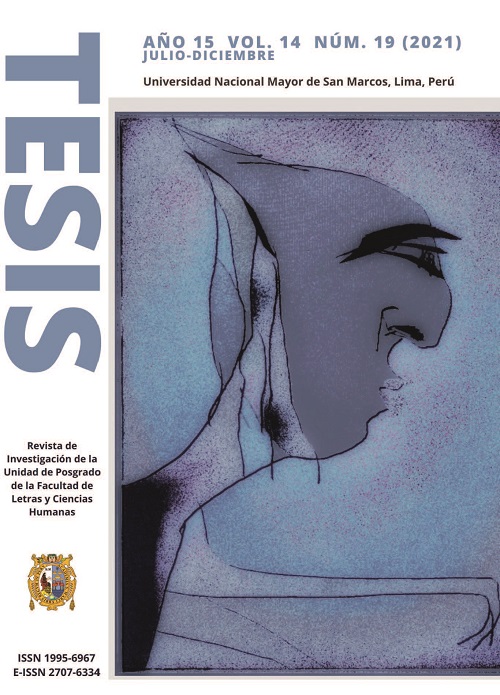Identity and attitude about the process of extinction of Quechua in the bilingual inhabitants of the district of Pontó (Ancash)
DOI:
https://doi.org/10.15381/tesis.v14i19.21490Keywords:
linguistic attitude, bilingualism, language extinction, identity, Quechua languageAbstract
The present article, which derives from a master’s thesis in Linguistics carried out at the Universidad Nacional Mayor de San Marcos, aims to identify the relationship between the identity and attitude of the bilingual inhabitants of the district of Pontó, province of Huari, Ancash region, on the process of extinction of the Quechua language. Two questionnaires were applied to collect information on the identity and attitude towards their native language in people of different ages. The results obtained indicate that Quechua is generally spoken by the elderly, specifically in those over 60 years; consequently, it is threatened and dominated by the growing castellanization in the area of Pontó (Ancash), a similar aspect that occurs in most South American countries with respect to their native languages.
References
Areiza, R., Cisneros, M. y Tabares, L. (2004). Hacia una nueva visión de la sociolingüística. Ecoe Ediciones.
Almeida, M. (1999). Sociolingüística. Gráficas Sabater.
Benites, K. (2019). Actitudes lingüísticas de migrantes bilingües andinos en San Juan de Lurigancho. [Tesis de licenciatura en Lingüística, Universidad Nacional Mayor de San Marcos]. https://cybertesis.unmsm.edu.pe/handle/20.500.12672/10572
Cárdenas, E. (2013). Bilingüismo y educación Indígena. Reencuentro. Análisis de Problemas Universitarios, (66), 24-30. https://www.redalyc.org/articulo.oa?id=34027019003.
Castillo, H. (2007). Mismo mexicano pero diferente idioma: identidades y actitudes lingüísticas en los maseualmej de Cuetzalan. Instituto de Antropología e Historia: Universidad Nacional Autónoma de México.
Coulmas, F. (1997). An Introduction to sociolinguistics. UK: CUP.
De la Herrán, G., A. y Rodríguez, B. Y. (2017). Indicadores de supervivencia y muerte de culturas y lenguas indígenas originarias en contextos hispanohablantes excluyentes: la enseñanza como clave. Revista Ibero-americana de Educación, 73(1), 163.
Falcón, P. (2018). Identidades y preferencias lingüísticas en comunidades de la Selva Central del Perú. Letras (Lima), 89(129), 128-153. https://dx.doi.org/10.30920/letras.89.129.6.
Falcón, P. y Mamani, L. (2017). Actitudes lingüísticas en contextos interculturales: población asháninka bajo Chiari. Revista de Lingüística Teórica y Aplicada, 51(1), 95-115. https://scielo.conicyt.cl/pdf/rla/v55n1/0718-4883-rla-55-01-00095.pdf.
González, J. (2009). Actitudes lingüísticas en Els Port (Castellón) y Matarraña (Teruel). [Tesis doctoral, Universidad Nacional de Educación a Distancia, Madrid].
Hirsh, N. y Limo, A. (2007). Consecuencias sociales del contacto lingüístico: diglosia y actitudes lingüísticas. En P. Córdova y M. Aguirre (Eds.), ¿Cambio o muerte de las lenguas? Reflexiones sobre la diversidad lingüística, social y cultural del Perú. Fondo Editorial de la Universidad Peruana de Ciencias Aplicadas.
Lastra, Y. (1997). Sociolingüística para hispanoamericanos: una introducción. Centro de Estudios Lingüísticos y Literarios.
Merlo, S. (2015). Tendencias y vigencia de la lengua aymara en los pobladores residentes en Viacha. Universidad Mayor de San Andrés. Facultad de Humanidades.
Orihuela, O. y León, Y. (2015). Proceso de extinción y desprestigio del quechua-wanka, en el anexo de Cochangará, 2013. [Tesis de licenciatura, Universidad Nacional del Centro del Perú]. http://hdl.handle.net/20.500.12894/168 9.
Ríos, D. (2016). Actitudes e ideologías lingüísticas en una comunidad educativa plurilingüe: estudio de caso del Lycée Antoine de Saint Exupéry. [Tesis de maestría en Lingüística, Universidad de Chile].
Silva-Corvalán, C., y Arias, A. (2017). Sociolingüística pragmática del español. (2.a ed.). Georgetown University.
Skrobot, K. (2014) Las políticas lingüísticas y las actitudes hacia las lenguas indígenas en las escuelas de México. [Tesis doctoral en Filología Hispánica, Universidad de Barcelona].
Villari, C. (2016). Observaciones sobre la situación socio-lingüística de Huaraz (Áncash, Perú). Indiana, 33(1), 91-107. https://www.redalyc.org/journal/2470/247046764005/html/
Zajícová, L. (2017). Lenguas indígenas en la legislación de los países hispanoamericanos. Onomázein, número especial, 171-203. http://onomazein.letras.uc.cl/Articulos/Nespecial-Amerindias/AM10- Zajicova.pdf
Downloads
Published
Issue
Section
License
Copyright (c) 2021 Nicolás Tolentino Pimentel Torres

This work is licensed under a Creative Commons Attribution 4.0 International License.
THE AUTHORS RETAIN THEIR RIGHTS:
(a) The authors retain their trademark and patent rights, and also on any process or procedure described in the article.
(b) The authors retain the right to share, copy, distribute, execute and publicly communicate the article published in Tesis (Lima) (in example, depositing the article in an institutional repository or publish it in a book), with recognition of its initial publication in the Tesis (Lima).
(c) The authors retain the right to make a later publication of their work, to use the article or any part of it (for example: a compilation of their works, notes for conferences, thesis, or for a book), provided that they indicate the source of publication (authors of the work, magazine, volume, number and date).






